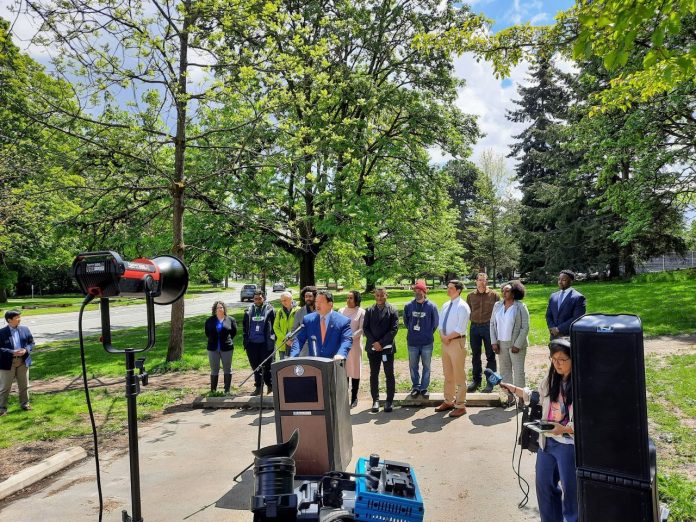
On Thursday, Mayor Bruce Harrell promised the imminent release of housing data dashboard that will show his administration is on course to meet a campaign pledge of producing 1,000 units of emergency housing and shelter beds in his first six months in office. Until the dashboard is out, The Urbanist is unable to substantiate the veracity of that claim. The pledge came at a press conference held near the Woodland Park dog park, marking the removal of a large encampment of homeless people, with Councilmember Dan Strauss offering the Mayor his backing for the “human-centered” approach to encampment removal that included 89 referrals to shelter or supportive housing, the City reported.
In other housing news, House Our Neighbors’ social housing ballot initiative scored a big endorsement from the MLK County Labor Council and housing reports from the Seattle Office of Housing showed another big year of production, buoyed by a record year of Mandatory Housing Affordability proceeds and 502 new unit opening via Multi-Family Tax Exemption program. A public comment period is open on an affordable housing proposal on a County-owned park-and-ride site next to Northgate Station that would bring 232 homes to this transit-rich location.
At a design review meeting on Tuesday evening, the builder of a 45-story residential tower at 8th Avenue and Blanchard Street will be seeking design approval that would clear the way for a land use permit. The proposal would bring 418 homes and 57 underground parking stalls if approved by the Downtown Design Review Board. Will the discerning architects review committee deem worthy the project’s “pleated façade,” color palate, and street activation efforts? Tune in to find out. And sign up to testify or submit a comment to the assigned City planner to push the project over the top by sending an emailing prc@seattle.gov.
Just west down the Denny Way corridor, another 45-story apartment proposal has emerged and is getting an Early Design Guidance meeting on June 7th. The Belltown site (616 Battery Street) used to host an Elephant Car Wash with a neon pink elephant sign that became iconic as car wash signs go. The elephant sign is being preserved and will be displayed at the Museum of History and Industry, with Amazon chipping in to pay for the restoration.
Woodland Park sweep
The Harrell Administration called the Woodland Park the city’s last remaining large homeless encampment in its parks, and it was cleared earlier this week. On the campaign trail, Harrell told supporters he’d have the Green Lake area cleared of homeless encampments by February. The City said 89 people were given referrals to shelters, tiny homes, or supportive housing units, although less than half of the City’s referrals lead to people accepting shelter or housing, according to reporting by Erica Barnett of PubliCola. As during his campaign, Mayor Harrell continued to insist encampment removals that his administration conducts are not sweeps: “We don’t do sweeps in Seattle,” he said. However, the distinction is murky. Real Change News, whose model centers employing homeless people and being the voice of low-income and homeless people, and PubliCola have continued to use the term.
Real Change News covered what the Woodland Park encampment sweep looked like on the ground, with a fair bit of chaos as people tried to secure transport for themselves and their belongings to their next living situation. Finding 89 open beds at one point on time was a bit of feat, but the City scrambled and found enough referrals, leaning heavily on the Low Income Housing Institute (LIHI), which fortunately had a slew of tiny home spots opening up.
Deputy Mayor Tiffany Washington, who leads on homelessness for the Mayor, was in attendance, as was Marc Dones, CEO of the King County Regional Homelessness Authority (KCRHA). Officially, KCRHA coordinates all of the regional homelessness response except for encampment removals, and Dones and the KCRHA have been critical of some removals, such as the more abrupt sweep at Civic Square across from Seattle City Hall. However, Dones praised the more deliberate approach taken at Woodland Park, and officials and service providers commended each other for their hard work, while also acknowledging more work to be done. King County estimated the number of people who experienced homelessness within its borders during 2020 at just over 40,000.
“This isn’t a victory lap, because not everybody is housed,” Dones said. “This cannot be the end… This has to a proof of concept that we use to scale resources and to scale will to get this done and end homelessness in this county.”
Dones also celebrated the collaborative and focused approach from Councilmember Dan Strauss and the incoming mayoral administration. After Strauss reached out, Dones noted they had weekly coordinating calls to zero in on solutions.
“The focus was work: What are we learning? Who do we know? Do we understand their needs?” I have to say, in over 15 years of public service, I’ve never seen a sitting councilmember and a deputy mayor do the work. Not once. So this is also extraordinary, and thank you for your leadership,” Dones said of Deputy Mayor Washington and Councilmember Strauss.
Bed availability determined the pace of the sweep, Dones said. Barnett has dubbed this approach a “slow-motion sweep.” Mayor Harrell pledged to clear Woodland Park of encampments during his mayoral campaign and the sweep had been prefaced for months with providers conducting outreach with campers to connect them to resources. In fact, providers reported that additional homeless people moved into Woodland Park just before the sweep because they heard tiny homes and shelter beds were being offered. Dones and Washington said this a sign of success that trust was being restored and offers of emergency housing work.
Councilmember Dan Strauss said the Woodland Park removal, along with the early Ballard Commons Park removal, constituted a new model for the city to follow to clear encampments in a “human-centered” way. Strauss also said the city had a real leader in the mayor’s office, which appeared to be a dig at former Mayor Jenny Durkan, who often squabbled with City Council over homelessness policy, squandered opportunities to deploy federal resources, and sought to block Council efforts to increase investments, leaving a real mess behind.
Mayor Harrell insists that North Seattle isn’t getting special treatment and his administration has an overarching strategy to fairly and equitably offer housing and mental health services resources to all council districts and neighborhoods, not just those that complain the loudest about encampments.
To improve outcomes and raise the rate of homeless people accepting referrals, Dones credited the by-name lists REACH and other service providers used to connect homeless residents to shelter and services. Dones said the referral acceptance rate was higher from the Woodland Park camp thanks to the trust and relationships that were being built. This intensive approach takes service provider capacity and housing capacity to keep people housed as their shelter stays come to an end. Whether the people removed from Woodland Park will continue to be on the path out of homelessness and into stable housing remains to be seen.
Harrell’s housing data dashboard dropping soon
At the Woodland Park press conference, Mayor Harrell also pledged to release a data dashboard by month’s end showing where his administration stands on his promise to produce 1,000 shelter beds or emergency housing units in his first months.
Harrell won’t be able to let up at that point either, as he pledged another 1,000 emergency housing units by end of his first year. This matches the 2,000 homes promised in the Compassion Seattle ballot measure that was struck down by the court as an improper use of the charter amendment process, but that Harrell endorsed and incorporated into his campaign platform. Harrell’s “director of strategic initiative” is former councilmember and fill-in mayor Tim Burgess, who also led the Compassion Seattle effort.
Mayor Harrell said his dashboard would show where encampment removals are happening and where tiny homes, permanent supportive housing units, and shelter beds were coming online. Apparently they will add up to 1,000 new units by July, but the definition of what counted toward the total will be interesting. Compassion Seattle pledged to produce 2,000 units of “emergency housing” beyond existing plans. The definition of “emergency housing” was a little broad and vague, however. Meeting the Compassion Seattle pledge will be a tall task for the Harrell Administration, data dashboard or no.
Without a steady stream of new low-income housing units coming online, it may be tough for Harrell to continue to squeeze homeless encampments out of prominent areas and prevent them from swelling in size, let alone taking the next step of tackling the smaller encampments that continue to creep up all over the city.
MLK Labor endorsed I-135 Social Housing Initiative
In endorsing Initiative 135 on Thursday, leaders from the MLK County Labor Council noted how much affordable housing meant to their members and stressed a public developer of social housing like the House Our Neighbors coalition has proposed could help. Jennifer Matter, Seattle Education Association President, said the lack of deeply affordable housing at all levels of income has reached a crisis level in Seattle.
“It’s difficult to overstate the impact that the housing affordability crisis has on our members, our students and our school communities. Students come to class from shelter beds, educators commute for hours from out of the city to teach, and many more have left our schools entirely because they’ve been priced out of the city by soaring rents,” Matter said in a statement. “SEA supports I-135 as a means for bringing more permanently affordable housing units to this city, so that our school communities can stay intact, and our members can afford to live in the communities where they teach. Living conditions are learning conditions.”
MLK Labor voted Wednesday to endorse the measure, but several member unions had also endorsed individually including UFCW 3000, SEIU 6, the Seattle Education Association, AFT Seattle, and UAW 4121.
“More and more essential grocery, retail and healthcare workers are being priced out of Seattle, forced to move away from their workplaces and their communities and face growing housing insecurity,” said Shawn Hayenga, a UFCW 3000 member and Sand Point Metropolitan Market worker. “There are also those in our community with no other option but to come to a grocery store or an emergency room seeking a warm, dry place or a parking lot to sleep. That is why UFCW 3000 endorses I-135. We need more housing and we need it to be affordable.”
In contrast, nonprofit homebuilders have been wary and skeptical. Housing Development Consortium came out against I-135 in April, worrying that it could pull resources from the conventional nonprofit model of developing affordable housing and jeopardize prospects for Seattle Housing Levy renewal in 2023. (Seattle’s 2016 housing levy passed with more than 70% of the vote.) House Our Neighbors has countered that the public developer can coexist and complement nonprofit efforts while helping to ramp up housing production to meet the urgent need.
“We can’t let another year go by where more folks enter homelessness due to out-of-control rents, and where more of our Black, Brown, Indigenous, and low-income community members are priced out of this City,” House Our Neighbors said in a statement. “Social housing provides an alternative to forcing workers to commute 30-60 minutes each way, losing precious time with their families, just to be able to find housing that meets their income. This model also provides stability and peace of mind for workers who are exhausted by the mental burden of never knowing when their rent will increase to the point that they must leave the city.”
By seeking to serve people at up to 120% of area median income (AMI), the public developer would also contribute toward filling in the missing middle range of housing needs between those who qualify for affordable housing (below 60% of AMI) and those who can comfortably affordable market-rate housing in Seattle, which often takes 120% or more of AMI, particularly for families, given how expensive multi-bedroom apartments are in Seattle.
Even one bedroom apartment rents are pricey with $2,190 coming in at average in Seattle, according to RentCafe estimates. Multi-bedroom apartments, however, cost much more and compose just a fifth of the market. “If you are renting an average priced 2-bedroom apartment in Seattle, your annual salary should be around $142,920 or higher,” Apartment List notes, given the $3,573 average price citywide.
Resultingly, many Seattle tenants are rent-burdened. In 2020, 45.3% of renter households spent on average more than 30% of their income on housing, a Construction Coverage study found. Moreover, a City-commissioned April 2021 study found “nearly 46,000 [Seattle] households are spending more than half of their incomes on housing costs, which classifies them as severely cost-burdened by federal standards.”
“Our members are Black, brown, immigrant, and working class,” said Zenia Javalera, President of SEIU 6. “We are the folks who keep Seattle clean and safe – why should we be paying half our income on housing? Why should we spend all this money on gas and miss precious time with our families because we’re stuck with long commutes?”
Plans advancing for Northgate TOD site
A long-delayed proposal to add affordable housing next to Northgate Station is taking a step forward by a land use application to the Seattle Department of Construction and Inspections (SDCI). Bridge Housing and Community Roots are collaborating to produce 232 homes on a corner of a County-owned Northgate park-and-ride lot. Community Roots will operate the building once it opens. Being immediately adjacent to light rail, no on-site parking is proposed. In addition to providing land, the County is contributing $20 million to help finance the affordable housing project.
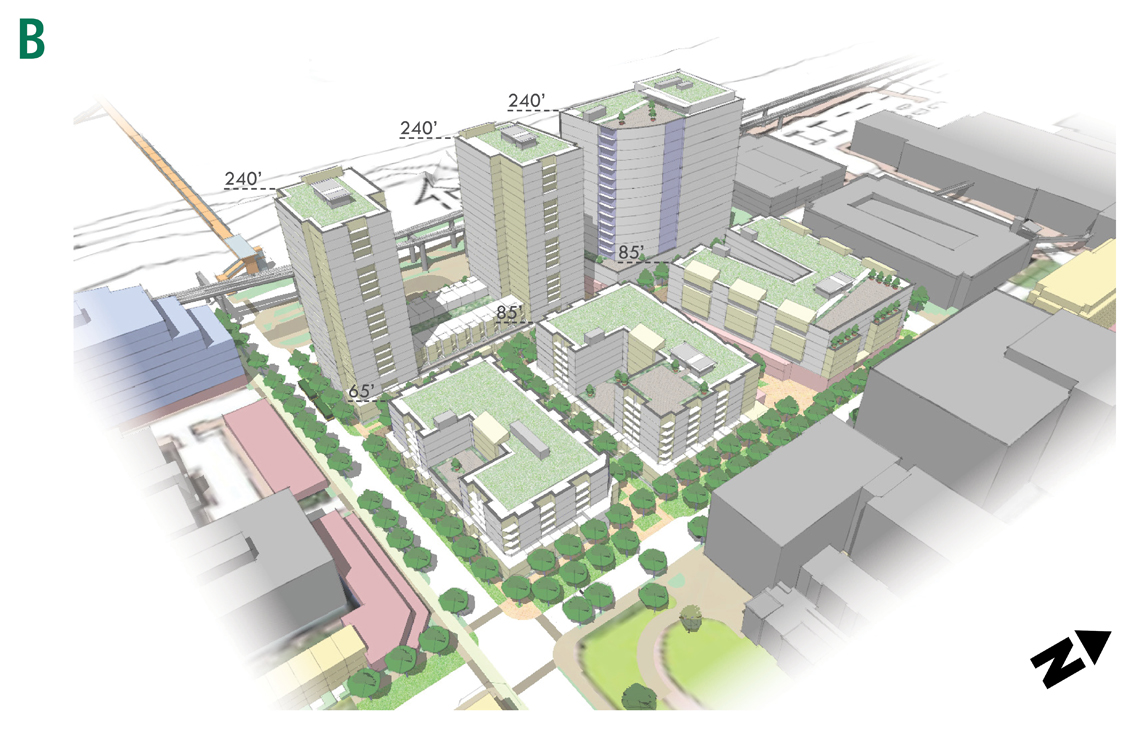
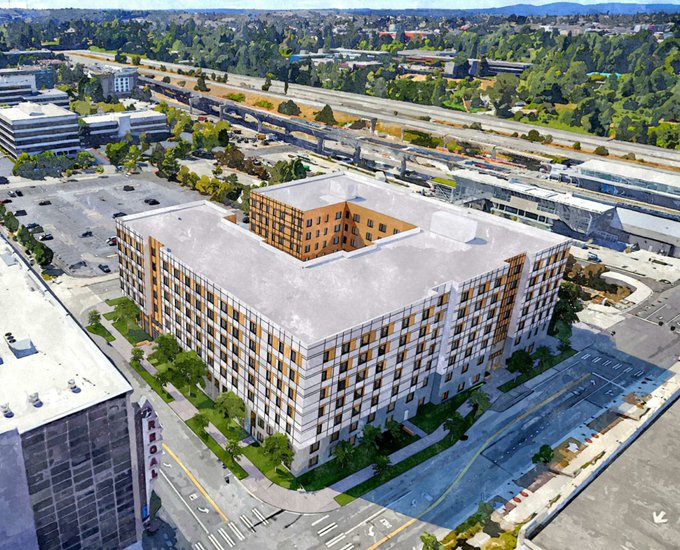
King County Metro had studied putting highrise development on the site, which is zoned to allow buildings up to 240 feet in height, but the agency decided to proceed with a smaller nonprofit proposal after talks with a private developer stalled and fell though. Metro’s first Request for Proposals (RFP) went out in 2017, with an original goal of opening the housing by the time Northgate Link opened in 2021, which has obviously came and went.
Later in 2022, Metro has pledged to reveal its plans for the remainder of the lot, which could host upwards of 600 homes if built to full zoned capacity. Metro has said it would prefer to keep most of the surface parking spots available until the Lynnwood Link extension opens, which is expected in 2024, relieving parking pressure on Northgate. But at that point, there is hope that the site could host highrises with hundreds of affordable homes.
The design review recommendation meeting for the 232-home proposal hasn’t been scheduled yet.
45-Story Tower on Blanchard Seeking Design Review TOD
A 45-story proposal containing 418 apartments is seeking design review approval Tuesday. The project is sandwiched between Butcher’s Table and a Shake Shack on a triangular block formed by the intersection of Blanchard Street and Westlake Avenue. Architects have proposed “pleated façade” and a cantilevered design over a narrower base to add visual interest in a corner of the city that has seen a ton of highrise apartment development. Seattle in Progress estimates the Denny Way corridor has more than 10,000 apartments in the works, including a pair of wavy twin towers that is nearing completion.

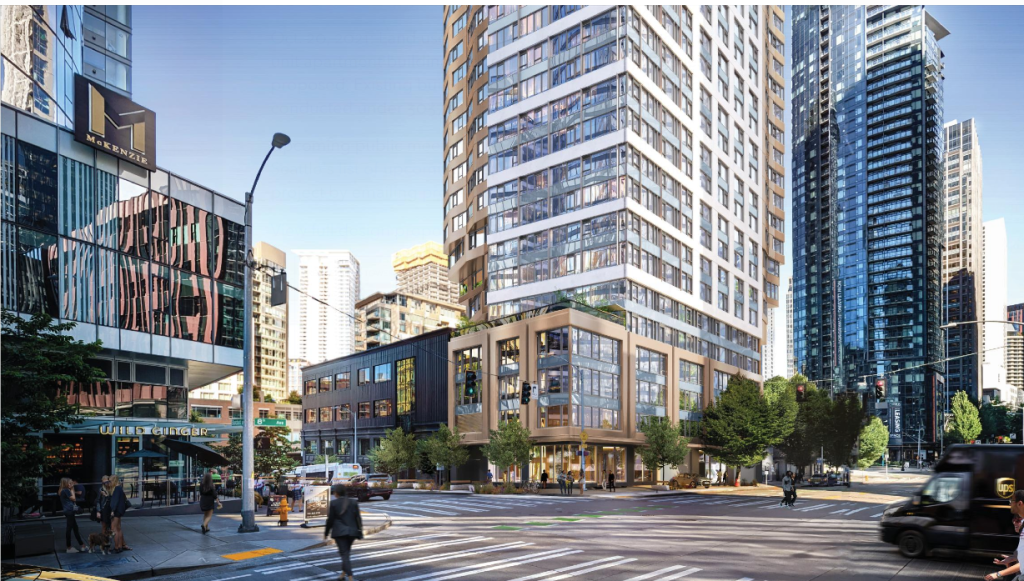
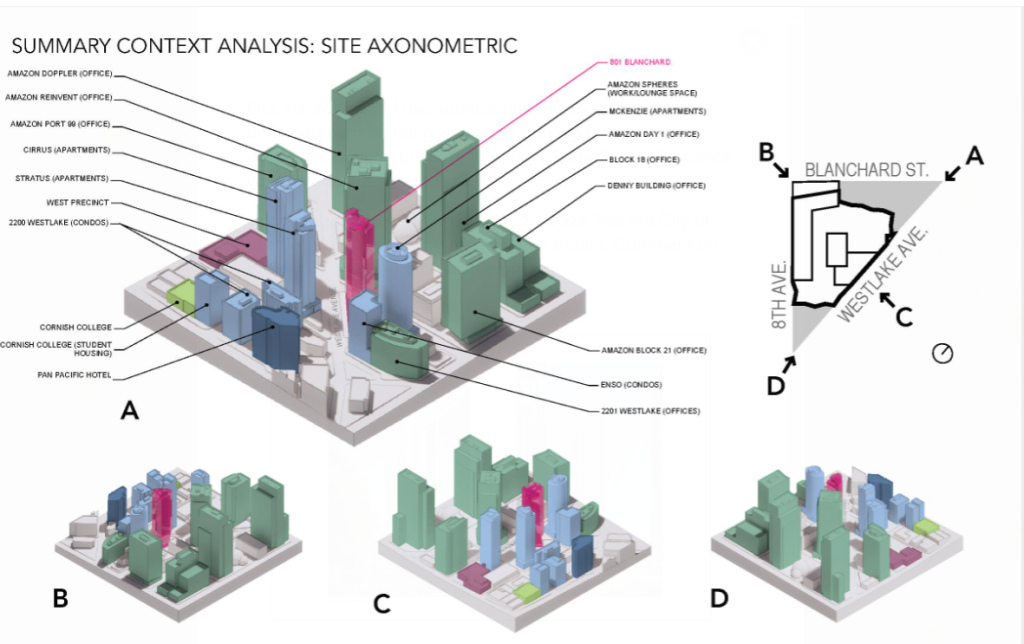
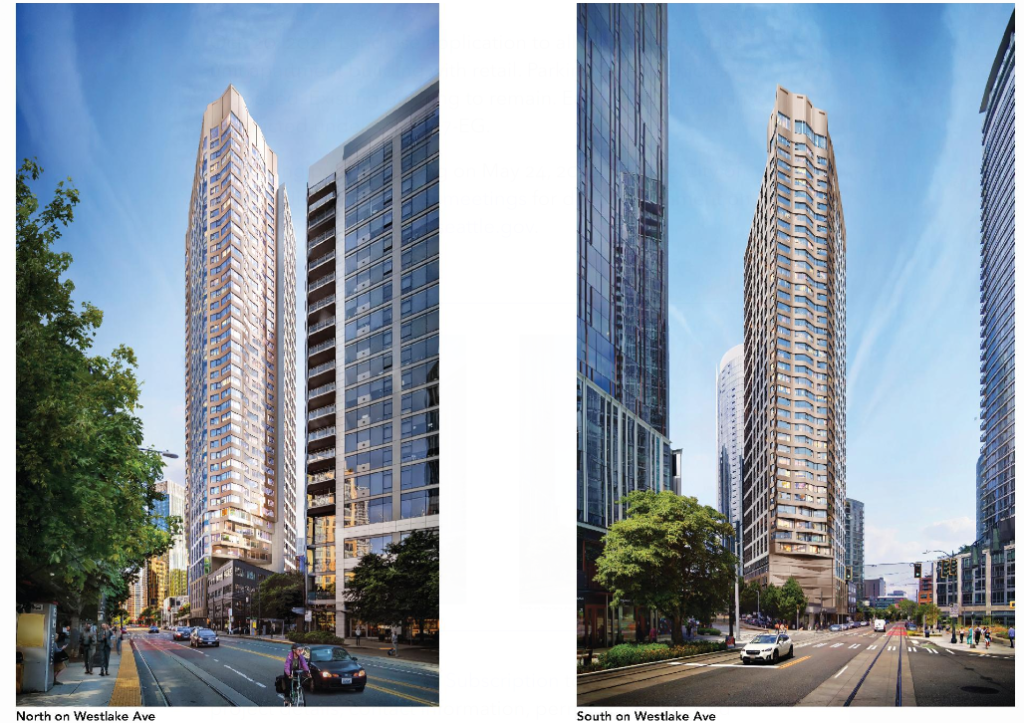
The builder is seeking three design code departures related to green street upper level setbacks guidelines, 16-foot-wide rather than recommended 18-foot-wide Westlake Avenue sidewalk width, and common recreation space on the rooftop. If the design review board rejects these departures, the developer will likely need to adjust the design.
If interested in commenting, sign up to testify or submit a comment to the assigned City planner to push the project over the top by sending an emailing prc@seattle.gov. If the design review board withholds it recommendation, the architects will need to come back to a future meeting and present a revised proposal, which can add significant costs to the developer.
The design review program is in the midst of a reform effort with a 16-member workgroup meeting though the end of the year to come up with recommendations for improvements. A coalition led by Seattle For Everyone (of which The Urbanist is a member) is urging reforms to create a simpler, quicker, and more streamlined process. Design review times have creeped up to an average of 18 months in recent years, which is about three times longer as Tacoma’s permit times. Implementing reforms would ultimately be up to the Harrell administration, with legislative reforms would also need a City Council stamp of approval.
Permanent supportive housing projects are exempt from full design review and go through streamlined design review thanks to a 2021 City Council reform shepherded by Councilmember Andrew Lewis.
Seattle’s MFTE program produces 502 affordable homes in 2021
The Seattle Office of Housing released a report this month showing the City’s Multi-Family Tax Exemption (MFTE) program produced 502 new affordable units in 2021. Participating buildings produced 2,330 homes overall, counting market-rate units. The MFTE program offers landlords a property tax break in exchange for setting aside a share of new units (20% or 25%) as below-market rent-restricted units.
By state law, new apartments can only be in the MFTE program for 12 years maximum, which means some buildings have aged out of the tax break and affordability requirement. In 2019, a Joint Legislative Audit and Research Committee report deemed the role of MFTE in boosting housing production as inconclusive, but developers tend to like it.
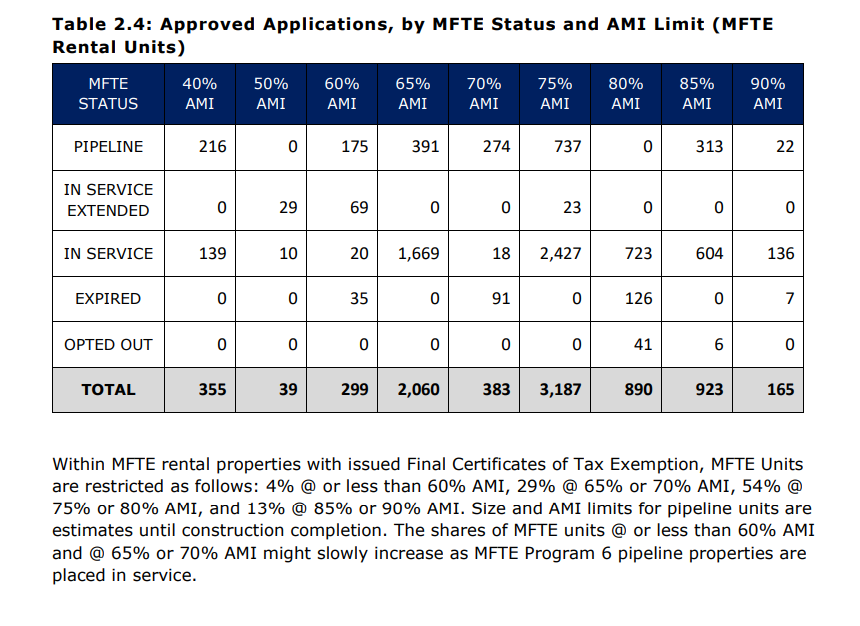
MHA affordable housing revenue hits new high in 2021
In his remarks Thursday, Councilmember Dan Strauss noted 2021 was the first year Seattle met its goal of $200 million in annual investments in affordable housing. In her comments ahead of Council’s Affordable Housing Week proclamation, Councilmember Teresa Mosqueda noted that investment in translating to increased affordable housing production.
“There are over 5,400 new affordable units currently under development, with 4,000 of those opening in this upcoming year,” Mosqueda said. “That’s an incredible investment.”
One big piece of meeting that mark was the MHA program, which posted a record haul in 2021. The Seattle Office of Housing revealed that last year MHA raised almost $76 million in fees and produced 95 rent-capped units on-site in its annual housing reports released earlier this month. This edged out MHA’s 2020 haul of $68 million in fees and 21 on-site units. The Seattle Office of Housing said the 2021 MHA haul will fund more than 900 affordable homes (past projects are laid out in its investment report). From its inception through the end of 2021, MHA has pulled in $171.4 million. Even with the recent surge in production, only about 9% of Seattle’s housing stock is composed of affordable rent-restricted homes.
Seattle may well be of course to set a new MHA high in 2022 as development activity continues to rebound from a pandemic freeze.
Doug Trumm is publisher of The Urbanist. An Urbanist writer since 2015, he dreams of pedestrian streets, bus lanes, and a mass-timber building spree to end our housing crisis. He graduated from the Evans School of Public Policy and Governance at the University of Washington in 2019. He lives in Seattle's Fremont neighborhood and loves to explore the city by foot and by bike.

